八年级英语上册时态总复习word
- 格式:docx
- 大小:13.67 KB
- 文档页数:6
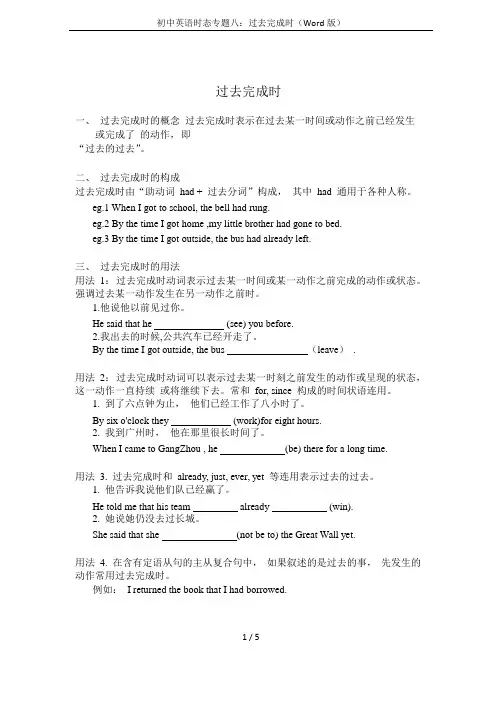
初中英语时态专题八:过去完成时(Word版)过去完成时一、过去完成时的概念过去完成时表示在过去某一时间或动作之前已经发生或完成了的动作,即“过去的过去”。
二、过去完成时的构成过去完成时由“助动词had + 过去分词”构成,其中had 通用于各种人称。
eg.1 When I got to school, the bell had rung.eg.2 By the time I got home ,my little brother had gone to bed.eg.3 By the time I got outside, the bus had already left.三、过去完成时的用法用法1:过去完成时动词表示过去某一时间或某一动作之前完成的动作或状态。
强调过去某一动作发生在另一动作之前时。
1.他说他以前见过你。
He said that he (see) you before.2.我出去的时候,公共汽车已经开走了。
By the time I got outside, the bus (leave).用法2:过去完成时动词可以表示过去某一时刻之前发生的动作或呈现的状态,这一动作一直持续或将继续下去。
常和for, since 构成的时间状语连用。
1. 到了六点钟为止,他们已经工作了八小时了。
By six o'clock they (work)for eight hours.2. 我到广州时,他在那里很长时间了。
When I came to GangZhou , he (be) there for a long time.用法3. 过去完成时和already, just, ever, yet 等连用表示过去的过去。
1. 他告诉我说他们队已经赢了。
He told me that his team already (win).2. 她说她仍没去过长城。
She said that she (not be to) the Great Wall yet.用法4. 在含有定语从句的主从复合句中,如果叙述的是过去的事,先发生的动作常用过去完成时。
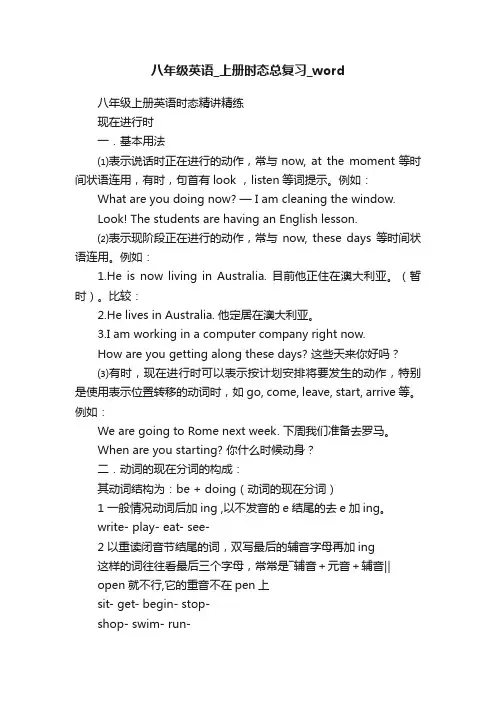
八年级英语_上册时态总复习_word八年级上册英语时态精讲精练现在进行时一.基本用法⑴表示说话时正在进行的动作,常与now, at the moment等时间状语连用,有时,句首有look ,listen等词提示。
例如:What are you doing now? — I am cleaning the window.Look! The students are having an English lesson.⑵表示现阶段正在进行的动作,常与now, these days等时间状语连用。
例如:1.He is now living in Australia. 目前他正住在澳大利亚。
(暂时)。
比较:2.He lives in Australia. 他定居在澳大利亚。
3.I am working in a computer company right now.How are you getting along these days? 这些天来你好吗?⑶有时,现在进行时可以表示按计划安排将要发生的动作,特别是使用表示位置转移的动词时,如go, come, leave, start, arrive等。
例如:We are going to Rome next week. 下周我们准备去罗马。
When are you starting? 你什么时候动身?二.动词的现在分词的构成:其动词结构为:be + doing(动词的现在分词)1 一般情况动词后加ing ,以不发音的e结尾的去e加ing。
write- play- eat- see-2 以重读闭音节结尾的词,双写最后的辅音字母再加ing这样的词往往看最后三个字母,常常是―辅音+元音+辅音‖open就不行,它的重音不在pen上sit- get- begin- stop-shop- swim- run-三.句子结构肯定结构:主语+am/is/are+doing(动词的现在分词)He is watching TV.否定形式:主语+am/is/are+ not+ doing.He is not watching TV.一般疑问句:Be(am/is/are)+主语+doing(动词的现在分词)?Is he watching TV? Are they singing now?特殊疑问句:疑问词+一般疑问结构?What is he doing?现在进行时专项练习一. 用括号中动词的适当形式填空:1. My parents ___ ____(watch)TV now.2 . Look. Three boys ___ ____(run).3. What _______ your mother ___ ____(do)now?4. _______ your dog _______ now?(sleep)5. _______ you _______(listen)to music? Yes, I am.6. Look, Miss Chen ___ ____ football.(play)7. Tom and his sister _______(wait)for you over there.8. Now Class 3 and Class 4_______(have)a test.9. Listen, someone _______(sing)in the classroom.10. ——Where is Zhang Yan?——She _______(talk)with her teacher in the teacher’s office.二. 选择填空:( )1. Who ______ over there now?A. singingB. are singC. is singing( )2. It’s nine ten. The students ______ a music class.A. haveB. havingC. are having( )3. Listen! The boy _______. A. crying B. is crying C. cries ( )4. Don’t talk here. Grandparents ______.A. sleepB. is sleepingC. are sleeping( )5. Is the man _______ tea or milk?A. drinksB. drinkC. drinking三. 按要求进行句型转换:1. Lily is dancing.(改为一般疑问句)________________________________________________2. Kate is looking for her watch.(改为否定句)________________________________________________3. Mrs. White is watching TV.(对划线部分提问)________________________________________________4. I am doing homework.(改为否定句)________________________________________________5. They are waiting for you at the library.(提问)___________________四. 根据中文提示完成句子:1他没在写作业,她在画画。
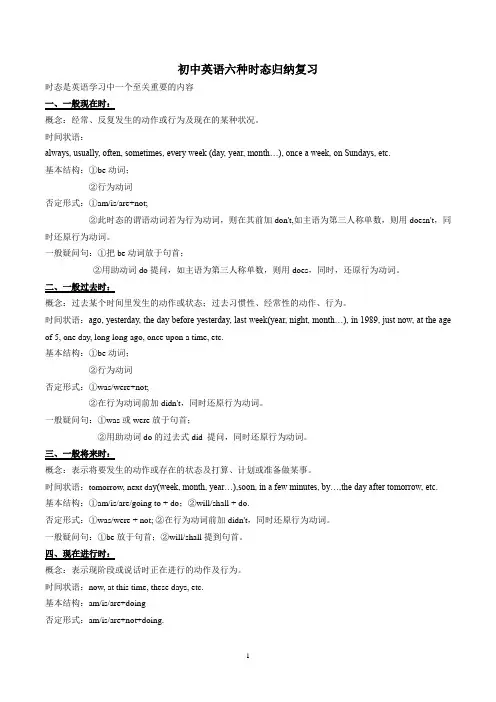
初中英语六种时态归纳复习时态是英语学习中一个至关重要的内容一、一般现在时:概念:经常、反复发生的动作或行为及现在的某种状况。
时间状语:always, usually, often, sometimes, every week (day, year, month…), once a week, on Sundays, etc.基本结构:①be动词;②行为动词否定形式:①am/is/are+not;②此时态的谓语动词若为行为动词,则在其前加don't,如主语为第三人称单数,则用doesn't,同时还原行为动词。
一般疑问句:①把be动词放于句首;②用助动词do提问,如主语为第三人称单数,则用does,同时,还原行为动词。
二、一般过去时:概念:过去某个时间里发生的动作或状态;过去习惯性、经常性的动作、行为。
时间状语:ago, yesterday, the day before yesterday, last week(year, night, month…), in 1989, just now, at the age of 5, one day, long long ago, once upon a time, etc.基本结构:①be动词;②行为动词否定形式:①was/were+not;②在行为动词前加didn't,同时还原行为动词。
一般疑问句:①was或were放于句首;②用助动词do的过去式did 提问,同时还原行为动词。
三、一般将来时:概念:表示将要发生的动作或存在的状态及打算、计划或准备做某事。
时间状语:tomorrow, next da y(week, month, year…),soon, in a few minutes, by…,the day after tomorrow, etc.基本结构:①am/is/are/going to + do;②will/shall + do.否定形式:①was/were + not; ②在行为动词前加didn't,同时还原行为动词。
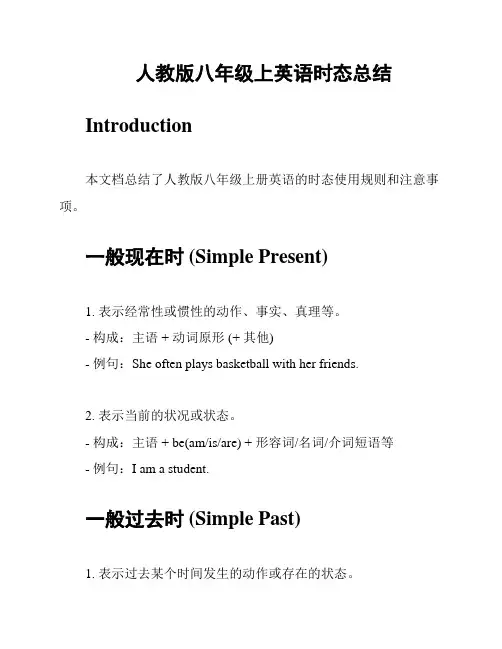
人教版八年级上英语时态总结Introduction本文档总结了人教版八年级上册英语的时态使用规则和注意事项。
一般现在时 (Simple Present)1. 表示经常性或惯性的动作、事实、真理等。
- 构成:主语 + 动词原形 (+ 其他)- 例句:She often plays basketball with her friends.2. 表示当前的状况或状态。
- 构成:主语 + be(am/is/are) + 形容词/名词/介词短语等- 例句:I am a student.一般过去时 (Simple Past)1. 表示过去某个时间发生的动作或存在的状态。
- 构成:主语 + 动词过去式 (+ 其他)- 例句:He studied English last night.一般将来时 (Simple Future)1. 表示将来某个时间或将来经常性发生的动作。
- 构成:主语 + will + 动词原形 (+ 其他)- 例句:They will visit their grandparents next week. 现在进行时 (Present Continuous)1. 表示当前正在进行的动作。
- 构成:主语 + be(am/is/are) + 现在分词(+ 其他) - 例句:She is watching TV right now.过去进行时 (Past Continuous)1. 表示过去某个时间正在进行的动作。
- 构成:主语 + was/were + 现在分词(+ 其他)- 例句:They were playing soccer at that time.高级时态1. 现在完成时 (Present Perfect)- 表示过去的某个时间到现在的动作或状态。
- 构成:主语 + have/has + 过去分词(+ 其他)- 例句:I have finished my homework.2. 过去完成时 (Past Perfect)- 表示过去的某个时间之前的动作或状态。
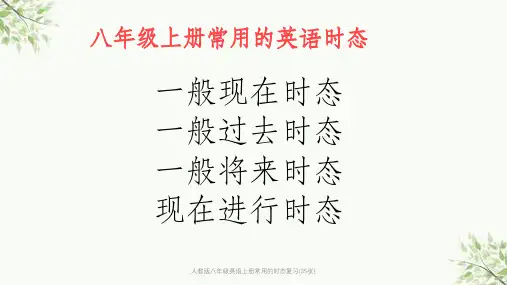
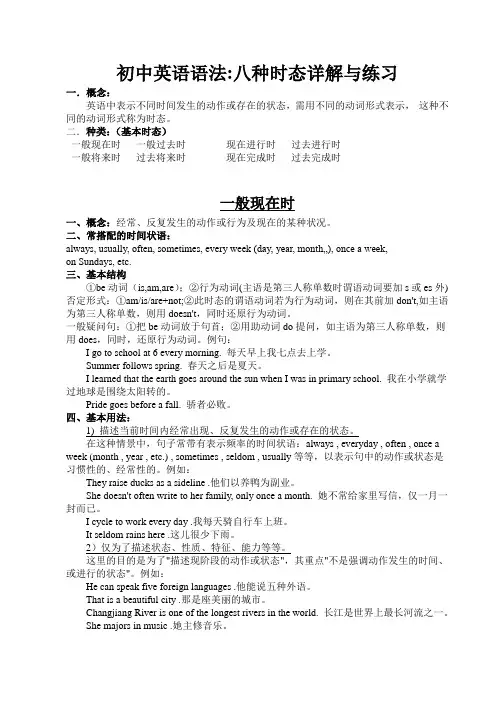
初中英语语法:八种时态详解与练习一.概念:英语中表示不同时间发生的动作或存在的状态,需用不同的动词形式表示,这种不同的动词形式称为时态。
二.种类:(基本时态)一般现在时一般过去时现在进行时过去进行时一般将来时过去将来时现在完成时过去完成时一般现在时一、概念:经常、反复发生的动作或行为及现在的某种状况。
二、常搭配的时间状语:always, usually, often, sometimes, every week (day, year, month…), once a week,on Sundays, etc.三、基本结构①be动词(is,am,are);②行为动词(主语是第三人称单数时谓语动词要加s或es外) 否定形式:①am/is/are+not;②此时态的谓语动词若为行为动词,则在其前加don't,如主语为第三人称单数,则用doesn't,同时还原行为动词。
一般疑问句:①把be动词放于句首;②用助动词do提问,如主语为第三人称单数,则用does,同时,还原行为动词。
例句:I go to school at 6 every morning. 每天早上我七点去上学。
Summer follows spring. 春天之后是夏天。
I learned that the earth goes around the sun when I was in primary school. 我在小学就学过地球是围绕太阳转的。
Pride goes before a fall. 骄者必败。
四、基本用法:1) 描述当前时间内经常出现、反复发生的动作或存在的状态。
在这种情景中,句子常带有表示频率的时间状语:always , everyday , often , once a week (month , year , etc.) , sometimes , seldom , usually等等,以表示句中的动作或状态是习惯性的、经常性的。
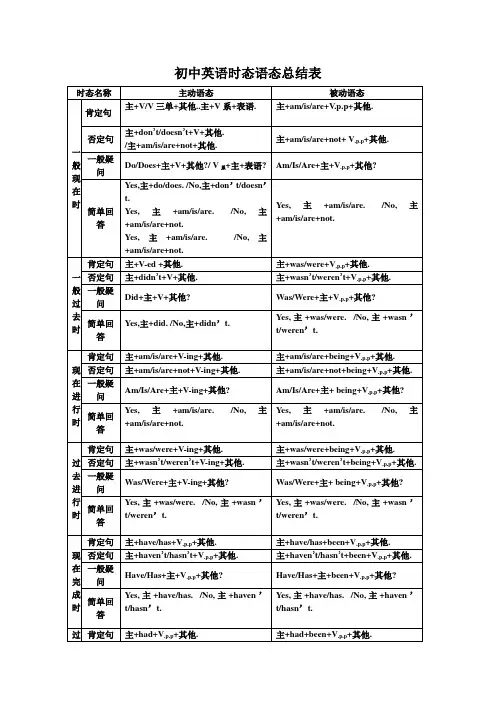
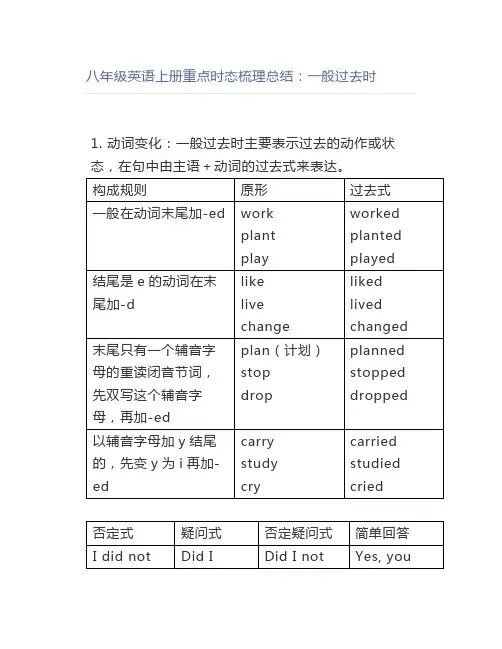

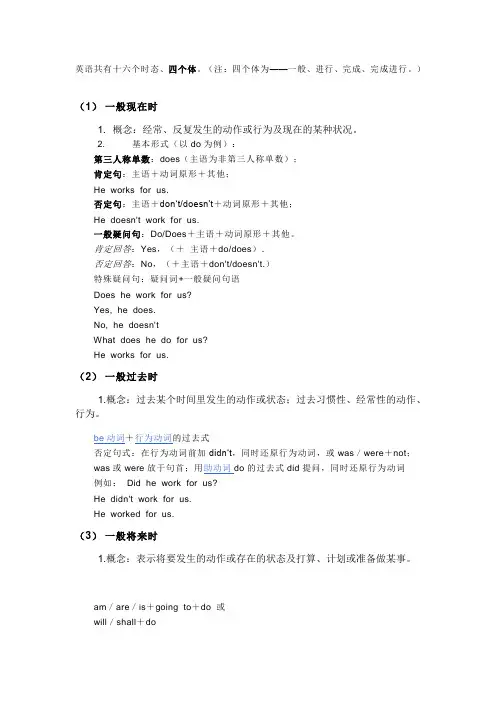
英语共有十六个时态、四个体。
(注:四个体为——一般、进行、完成、完成进行。
)(1)一般现在时1. 概念:经常、反复发生的动作或行为及现在的某种状况。
2. 基本形式(以do为例):第三人称单数:does(主语为非第三人称单数);肯定句:主语+动词原形+其他;He works for us.否定句:主语+don‘t/doesn't+动词原形+其他;He doesn't work for us.一般疑问句:Do/Does+主语+动词原形+其他。
肯定回答:Yes,(+主语+do/does).否定回答:No,(+主语+don't/doesn't.)特殊疑问句:疑问词+一般疑问句语Does he work for us?Yes, he does.No, he doesn'tWhat does he do for us?He works for us.(2)一般过去时1.概念:过去某个时间里发生的动作或状态;过去习惯性、经常性的动作、行为。
be动词+行为动词的过去式否定句式:在行为动词前加didn‘t,同时还原行为动词,或was/were+not;was或were放于句首;用助动词do的过去式did提问,同时还原行为动词例如:Did he work for us?He didn't work for us.He worked for us.(3)一般将来时1.概念:表示将要发生的动作或存在的状态及打算、计划或准备做某事。
am/are/is+going to+do 或will/shall+doam/is/are/about to + doam/is/are to + do;一般将来时的表达方法be going to +动词原形be +不定式,be to+动词原形,be about to +动词原形be able to +不定式be about to+动词原形will + 动词原形;例如:He is going to work for us.He will work for us;He is coming.这是特殊的用一般现在时表达将来时态的例子!!(4)过去将来时概念:立足于过去某一时刻,从过去看将来,常用于宾语从句中。
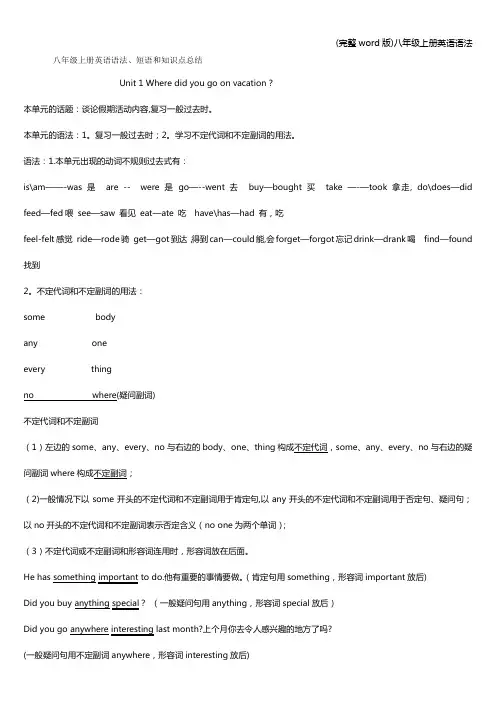
八年级上册英语语法、短语和知识点总结Unit 1 Where did you go on vacation?本单元的话题:谈论假期活动内容,复习一般过去时。
本单元的语法:1。
复习一般过去时;2。
学习不定代词和不定副词的用法。
语法:1.本单元出现的动词不规则过去式有:is\am——-was是are -- were是go—--went去buy—bought买take —-—took拿走, do\does—did feed—fed喂see—saw 看见eat—ate 吃have\has—had 有,吃feel-felt感觉ride—rode骑get—got到达,得到can—could能,会forget—forgot忘记drink—drank喝find—found 找到2。
不定代词和不定副词的用法:some bodyany oneevery thingno where(疑问副词)不定代词和不定副词(1)左边的some、any、every、no与右边的body、one、thing构成不定代词,some、any、every、no与右边的疑问副词where构成不定副词;(2)一般情况下以some开头的不定代词和不定副词用于肯定句,以any开头的不定代词和不定副词用于否定句、疑问句;以no开头的不定代词和不定副词表示否定含义(no one为两个单词);(3)不定代词或不定副词和形容词连用时,形容词放在后面。
He has something important to do.他有重要的事情要做。
(肯定句用something,形容词important放后)Did you buy anything special?(一般疑问句用anything,形容词special放后)Did you go anywhere interesting last month?上个月你去令人感兴趣的地方了吗?(一般疑问句用不定副词anywhere,形容词interesting放后)(4)不定代词和不定副词做主语时,后面的动词用单数形式。
八上时态汇总外研版七年级一整年学习了四个时态,分别为一般现在时、现在进行时、一般将来时和一般过去时。
八年级上M1回顾四大时态,以下是对四大时态的总结。
先利用表格思考具体时态的概念、时态状语及句式。
再讲解,加深印象。
最后结合练习提升时态运用能力。
一、一般现在时1.Lucy有时候会看书。
否定:________________________________________________________________________一般疑问句:__________________________________________________________________划线提问:____________________________________________________________________二、现在进行时2.安静!那个孩子在睡觉呢。
否定:________________________________________________________________________一般疑问句:__________________________________________________________________划线提问:____________________________________________________________________三、一般将来时3.他们下周要去打篮球。
否定:_______________________________________________________________________一般疑问:___________________________________________________________________划线提问:___________________________________________________________________四、一般过去时4.我们上周看了电影。
(完整版word)八年级上英语动词的时态复习总结含答案解析一、初中英语动词的时态1.He told me that he ________ here for five minutes.A.has comeB.had arrivedC.had beenD.had come【答案】C【解析】句意:他告诉我他到这儿5分钟了。
根据for five minutes可知谓语动词要用延续性动词,come和 arrive都是短暂性动词,be in+地点,表示延续性,here副词,要把介词省略;故选C2.--- Where’s my father? Could tell me?--- He to Beijing. He’ll attend an important meeting.A.goes B.is going C.has gone D.has been【答案】C【解析】【详解】句意:——我的父亲在哪里?可以告诉我吗?——他已经去北京了。
他将参加一个重要会议。
考查动词时态辨析。
根据句意语境,可知父亲不在说话的地点已经去了北京,需用现在完成时,可排除AC两项。
have been to意为“曾经去过某地”,现在已不在那里了;have gone to意为“到某地去了”,说话时作句子主语的人不在现场,故选C。
3.This medicine _______ millions of people’s lives since it was put into use.A.is saving B.will save C.has saved D.had saved【答案】C【解析】句意:这种药物自从投入使用以来已经挽救了数百万人的生命。
since后跟从句,表示“自……以来”,说明的是现在的状况,判断用现在完成时态,故答案为C。
4.—Are you a basketball player in you school?—Yes, I______the team 3 years ago.I______in it for 3 years.A.joined, was B.was joined, amC.have joined,have been D.joined, have been【答案】D【解析】【分析】句意:——你在你们学校是一名篮球运动员吗?——是的,我在3年前加入了篮球队。
北京四中编稿:向红丽责编:姜小敏八年级英语第一学期时态复习一、一般现在时1. 构成:①be动词:主语+be(am, is, are)+其它。
eg. I am a boy.我是一个男孩。
②行为动词:主语+行为动词(+其它)。
eg. We study English.我们学习英语。
当主语是第三人称单数时,动词必须用第三人称单数形式,动词第三人称单数形式的构成如下:一般在词尾加-s.eg. play-plays, swim-swims以字母s, x, sh, ch结尾的词加-es.eg. pass-passes, watch-watches, wish-wishes.以辅音字母加y结尾的单词,先变为y为i,再加-es.eg. study-studies, carry-carries.几个特殊单词:be-is, have-has, go-goes, do-does.动词第三人称单数形式的构成与发音和名词变复数相同。
③变为一般疑问句和否定句:如果句中无be动词或情态动词,则须加do(don't)、does(doesn't), 切记如果加了助动词,句中的谓语动词必须还原成原形。
回答这样的疑问句时也要含助动词。
eg. -Does he speak English?他讲英语吗?-Yes, he does./ No, he doesn't. 是的。
/不是。
She doesn't do sports after work. 她下班以后不做锻炼。
④连用的时间状语:一般现在时中常用的时间状语有often, usually, always, every day, every week, sometimes等。
eg. He speaks English every day. 他每天说英语。
2. 用法①表示经常性、习惯性的动作。
eg. He goes to school on foot. 他步行上学。
初二上学期要点语法一.形容词、副词的比较级和最高等在表示比较的时候,会出现三种状况:同级比较,比较级和最高等。
同比的构是:as...as...,意思是“⋯⋯和⋯⋯一”。
比如:He is as tall as his father.他和他的父一高。
He gets up as early as Tom every day.他每日和姆起得一早。
Special tips:as...as...的中要用形容或副的原形。
个句子构的否认形式表达的意思是“⋯⋯不如后者⋯⋯”。
比如:The pen is not as dear as that one.支笔没有那支。
比的构是:...than...,意思是“⋯⋯比⋯⋯更”。
比如:Today is colder than yesterday.今日比昨天冷。
Cars run faster than bikes.汽比自行跑得快。
Special tips:( 一)在指代二者中间的某个特点更明的象,能够用the 来特定化。
比如:He is the taller of the twins.他是双胞胎中比高的那个。
( 二)某个形容或副的比形式能够通and 接起来,表示“愈来愈⋯⋯”。
比如:It becomes older and older.它得愈来愈老。
He walks more and more quickly.他走得愈来愈快。
( 三) the +某一形容或副的比+ the +某一形容或副的比,表示“越⋯⋯,就越⋯⋯”。
比如:The more exercise you do,the healthier you will be.得越多,你就越健康。
The warmer it gets,the more people you can see in the street.天越温暖,你就会在街上看到越多的人。
( 四)固定构like...better than...表示的意思是指“与⋯⋯(后者)对比更喜⋯⋯(前者)”。
八年级上册英语时态精讲精练现在进行时一.基本用法⑴表示说话时正在进行的动作,常与now, at the moment等时间状语连用,有时,句首有look ,listen等词提示。
例如:What are you doing now? — I am cleaning the window.Look! The students are having an English lesson.⑵表示现阶段正在进行的动作,常与now, these days等时间状语连用。
例如:1.He is now living in Australia. 目前他正住在澳大利亚。
(暂时)。
比较:2.He lives in Australia. 他定居在澳大利亚。
3.I am working in a computer company right now.How are you getting along these days? 这些天来你好吗?⑶有时,现在进行时可以表示按计划安排将要发生的动作,特别是使用表示位置转移的动词时,如go, come, leave, start, arrive等。
例如:We are going to Rome next week. 下周我们准备去罗马。
When are you starting? 你什么时候动身?二.动词的现在分词的构成:其动词结构为:be + doing(动词的现在分词)1 一般情况动词后加ing ,以不发音的e结尾的去e加ing。
write- play- eat- see-2 以重读闭音节结尾的词,双写最后的辅音字母再加ing这样的词往往看最后三个字母,常常是“辅音+元音+辅音”open就不行,它的重音不在pen上sit- get- begin- stop-shop- swim- run-三.句子结构肯定结构:主语+am/is/are+doing(动词的现在分词)He is watching TV.否定形式:主语+am/is/are+ not+ doing.He is not watching TV.一般疑问句:Be(am/is/are)+主语+doing(动词的现在分词)?Is he watching TV? Are they singing now?特殊疑问句:疑问词+一般疑问结构?What is he doing?现在进行时专项练习一. 用括号中动词的适当形式填空:1. My parents ___ ____(watch)TV now.2 . Look. Three boys ___ ____(run).3. What _______ your mother ___ ____(do)now?4. _______ your dog _______ now?(sleep)5. _______ you _______(listen)to music? Yes, I am.6. Look, Miss Chen ___ ____ football.(play)7. Tom and his sister _______(wait)for you over there.8. Now Class 3 and Class 4_______(have)a test.9. Listen, someone _______(sing)in the classroom.10. ——Where is Zhang Yan?——She _______(talk)with her teacher in the teacher’s office.二. 选择填空:( )1. Who ______ over there now?A. singingB. are singC. is singing( )2. It’s nine ten. The students ______ a music class.A. haveB. havingC. are having( )3. Listen! The boy _______. A. crying B. is crying C. cries ( )4. Don’t talk here. Grandparents ______.A. sleepB. is sleepingC. are sleeping( )5. Is the man _______ tea or milk?A. drinksB. drinkC. drinking三. 按要求进行句型转换:1. Lily is dancing.(改为一般疑问句)________________________________________________2. Kate is looking for her watch.(改为否定句)________________________________________________3. Mrs. White is watching TV.(对划线部分提问)________________________________________________4. I am doing homework.(改为否定句)________________________________________________5. They are waiting for you at the library.(提问)___________________四. 根据中文提示完成句子:1他没在写作业,她在画画。
He _____ ____ __ homework. He __ __ ___ __ pictures. 2. 今天李老师穿着一件红色的连衣裙。
Miss Li ______ ______ a red dress today.3. 你爷爷在看报纸吗?______ your grandpa ___ ___ the newspaper?4. Tom和Jim在做什么?______ ______ Tom and Jim ______?5. 他们是在打篮球还是在打排球?______ they ______ basketball ______ volleyball?一般现在时一.用法1.表示现在的状态He is twelve. They are at home.2.表示经常性或习惯性的动作I go to school at seven every day.He plays soccer on Sundays.3.表示主语具备的性格和能力等She likes apples. They speak Japanese. She is medium build.二.句子结构1.主语+be+其他2. 主语+动词原形+---3. (当主语是第三人称单数时)主语+动词的第三人称单数形式+---肯定式I am a cleaner.We go to school at seven every day.He goes to school at 6 every day.否定式I am not a cleaner.We don’t go to school at seven.He doesn’t go to school at 6.疑问式及回答Are you a cleaner? Yes, I am. (No, I’m not.)Do you go to school at seven? Yes, we do.(No, we don’t.)Does he go to school at 6? Yes, he does.(No, he doesn’t.)注意:在上面的否定和疑问式中,do和does都没有意义,不用译出。
它们只是为了使句子完整,叫做助动词。
三.其他特征:A.一般现在时常和表示时间频度的副词连用。
如:often, usually, sometimes, always, never, hardly ever等。
(注意频度副词的位置:)1. I often read books in the evening2. Do they usually go to school by bike?3. He doesn’t like milk. He never drinks it.4. Sometimes my mother gets back at five.B.一般现在时常和以下时间表达法连用。
如:in the morning, in the afternoon, in the evening, at noon, at night, every day, on Sunday(s), at seven 等。
Do they have math in the morning?She sleeps nine hours every night.They don’t have classes on Sundays.动词第三人称单数的构成:1、直接加--s look—looks read—reads play—plays2. 在字母s, x,ch,sh,o后加--eswatch—watches wash—washes go—goes do—does3. 辅音字母加y结尾的动词变y为i,再加--escarry – carries study – studieshurry – hurries cry – cries4. 特殊的have -- has一般现在时专项练习选择填空() 1.A: How often ______ she exercise? B: Twice a week.A. doB. doesC. doingD. did() 2. I ______ like to drink milk.A. notB. doesn’tC. don’tD. no() 3. Good food and exercise ______ me to study better.A. helpB. helpsC. helpingD. to help() 4. Is her lifestyle the same ______ yours or different?A. asB. inC. atD. to() 5. I like ____ for breakfast.A.a bookB. a rulerC. an eggD. a sofa() 6. The ____are $21.A. glassesB. shoeC. tableD. bike() 7. Tennis ____ my favorite sport.A. areB. isC. amD. be() 8. I have a tennis and my friend Jim ____ two tennis rackets.A. haveB. playC. playsD. has() 9. “Let’s play computer games.” That ____ interesting.”A. looksB. soundsC. listensD. reads()10. My father likes football. But he ____ it.He only ____ football matches on TV!A. plays, watchesB. play, watchC. doesn’t play, watchesD. plays, doesn’t watch一般过去时意义:表示过去某个时间或某阶段已经发生或完成的动作或状态,和现在无关。